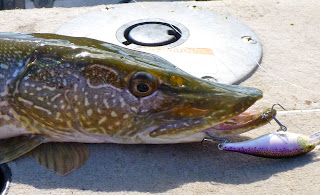Duck Dynasty
Here’s what I learned from the opening episode of A&E's Duck
Dynasty (in 24 minutes or less!)
You need to marinate your frogs in buttermilk before you fry
‘em. How much buttermilk? “No amount.
Any amount.”
You’ll know when you get it right.
I love this philosophy; it might be the Yin to my Yan of
Omnihilism.
While I'm precisely placing, tracking and replicating specifically chosen baits while trolling for pike, trout or salmon, my buddy is kind of just throwing lures out there and dragging them around. His lures are no distance (or any distance) behind the boat. Some days he even outfishes me, and he just about always enjoys himself more than I do. So I know he's on to something, and I know I should take the philosophy of Duck Dynasty's patriarch to heart.
And yet on the day I published "Omnihilism", I went fishing on Reeds Lake. It was the best Wednesday in several months, because I took some time off work to execute a plan. I targeted bass and pike, and I cast, jigged, and trolled; I used flat-lines, planer boards, and downriggers; reels were loaded with mono, fluoro, braid and lead core; I had two separate, filled tackle storage systems, a zillion lures and used a dozen different rods over the course of the day. Once again, I was doing it all, with the exception of fishing "how I usually do." Instead I was concentrating on new areas, lures and techniques. When the bass fishing crapped out (in anything from 2 to 45 feet of water), I turned to my pike. One hundred yards into the first troll with different lures away from the weed-edge and in deeper water, my Purpledecent Rapala Tail-Dancer was hit by a 28" pike; and in short order, I had gone 7 for 8 with 6 pike between 26 and 30 inches; a smaller pike, a perch, and a few other swings and misses. And all fish were taken in deep water, usually over 25 feet or more, and in my first attempt on Reeds Lake, I'd caught a few downrigger pike. The first rigger pike was the biggest of the day at 30 inches; and these deeper fish were fat compared to the stressed fish I've been encountering shallow in recent trips.
One of my rigger hits was extremely violent, but
then I was greeted with a slack line; the lure was simply gone. It could have been a pike of nearly any size,
or no size at all, but part of me likes to envision a real lunker.
So you can teach an old dog some new tricks, and while I'd taken a precise approach to the day, and it required a ton of tackle and effort, in the end I'd gotten it right. Just like those frog legs.
And yet on the day I published "Omnihilism", I went fishing on Reeds Lake. It was the best Wednesday in several months, because I took some time off work to execute a plan. I targeted bass and pike, and I cast, jigged, and trolled; I used flat-lines, planer boards, and downriggers; reels were loaded with mono, fluoro, braid and lead core; I had two separate, filled tackle storage systems, a zillion lures and used a dozen different rods over the course of the day. Once again, I was doing it all, with the exception of fishing "how I usually do." Instead I was concentrating on new areas, lures and techniques. When the bass fishing crapped out (in anything from 2 to 45 feet of water), I turned to my pike. One hundred yards into the first troll with different lures away from the weed-edge and in deeper water, my Purpledecent Rapala Tail-Dancer was hit by a 28" pike; and in short order, I had gone 7 for 8 with 6 pike between 26 and 30 inches; a smaller pike, a perch, and a few other swings and misses. And all fish were taken in deep water, usually over 25 feet or more, and in my first attempt on Reeds Lake, I'd caught a few downrigger pike. The first rigger pike was the biggest of the day at 30 inches; and these deeper fish were fat compared to the stressed fish I've been encountering shallow in recent trips.
 |
| This Purple Rap quickly became a favorite of mine! |
 |
| 30 inches of fat pike, off the downrigger! |
So you can teach an old dog some new tricks, and while I'd taken a precise approach to the day, and it required a ton of tackle and effort, in the end I'd gotten it right. Just like those frog legs.






